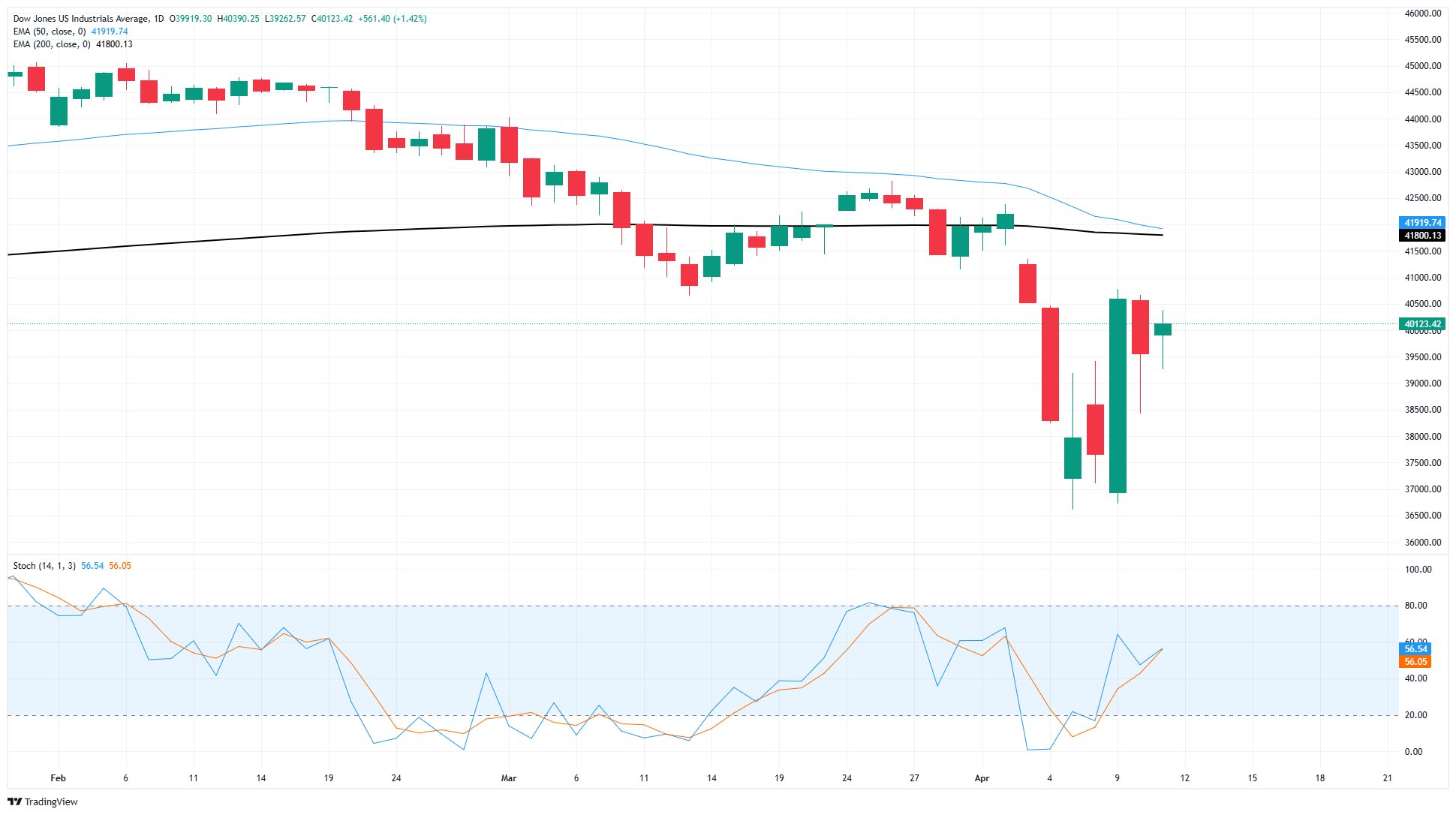- Dow Jones got stuck to 40,000 on Friday after a brief decrease in fresh tariff fears.
- American data was tender all over the world, and consumer moods have fallen and soothes PPI inflation.
- The ongoing commercial tensions will continue to burden markets when China and American square.
The industrial average Dow Jones (DJIA) caught the behind schedule offer on Friday, backing back to 40,000 main price handles after an early drop in growing tariffs between the USA and China. China raised tariffs to the US imports to 125%, because the country will continue to take revenge on rocket tariffs applied to Chinese goods imported to the USA, which increased to 145%.
Despite the triple tariffs in both directions, the staff of the White House remains adamant that President Trump remains optimist that a trade agreement between the USA and China will be achieved, helping to strengthen investors’ moods. Dow Jones gained almost 600 points on Friday, increasing the main capital index by 1800 points per week. Djia will still fall rapidly from record up, but the actions generally regained the ground this week after the Trump administration pulled away from its own skewed “mutual” tariffs.
The price indicator of the US manufacturer (PPI) softened even faster than expected in March, and the basic PPI fell to 3.3% y /. However, inflation pressure is still boiling in the background, because the markets are waiting to see how quickly tariff rainfall bleeds directly to the US economy.
The results of consumer research from the University of Michigan (UOM) have shown that tariff voltages with a wide base are driving at an economical consumer level perspectives and expectations of inflation. The UOM consumer mood indicator has fallen to many years low 50.8, and the consumer expectations indicator fell to the lowest level of 47.2, because more and more consumers are expecting recession in the coming year.
Expectations regarding consumer inflation increased to 6.7% from 5.0%, and 5 years of consumers’ inflation expectations also accelerated to 4.4% from 4.1%. Consumers are becoming more and more restless in the face of universal tariffs, and the expectations for inflation are risky that import prices will augment around the world.
Dow Jones price forecast
The industrial average Dow Jones caught another offer on Friday, only enough to understand Dow Jones back to the 40,000 handle to complete an extremely unstable week. DJIA achieved a 16-month minima near 36,600, after which she returned to the high side on geopolitical headers.
The price action is still caught on the 200-day-interpretation medium-medium (EMA) bear at 41,875, but the stubborn shoot is at a pace to continue grinding higher offers. The long -term technical inflection point rests on a 41,000 handle, near the low swing point in mid -March.
Dow Jones Daily Table

Dow Jones FAQ
The industrial average Dow Jones, one of the oldest stock market indicators in the world, is developed from the 30 most rotating operations in the USA. The index is rather weighted with the price, not weighted by capitalization. This is calculated by adding up the operating prices and dividing them by the factor, currently 0.152. The index was founded by Charles Dow, who also founded the Wall Street Journal. In later years he was criticized for not representative enough, because he follows only 30 conglomerates, unlike wider indicators such as S&P 500.
Many different factors drive the industrial average Dow Jones (DJIA). The main results of component companies revealed in the company’s quarterly reports are the main results. The condition and global macroeconomic data also contribute because they affect the mood of investors. The level of interest rates, determined by federal reserves (Fed), also affects DJIA, because it affects the cost of a loan on which many corporations are strongly dependent. Therefore, inflation can be the main driver, as well as other indicators that affect the FED decisions.
DOW theory is a method of identifying the basic stock exchange trend developed by Charles Dow. The key step is to compare the industrial direction of Dow Jones (DJIA) and medium transport of Dow Jones (DJTA) and follow only trends in which both move in the same direction. Volume is confirming criteria. The theory uses elements of peak analysis and the trough. Dow theory assumes three phases of the trend: accumulation when intelligent money begins to buy or sell; Society’s participation when a wider society is joined; And distribution when intelligent money comes out.
There are many ways to trade in DJIA. One of them is the apply of ETFs that allow investors to trade DJIA as one security instead of buying shares in all 30 components. The leading example is SPDR DOD Jones Industrial ETF (Dia). Djia Futures contracts enable traders by speculating the future value of the index and the options ensure the appropriate, but not the obligation, buying or selling the index at a predetermined price in the future. Investment funds enable investors to buy a diverse DJIA shares portfolio, thus ensuring a general exposure to the general indicator.
